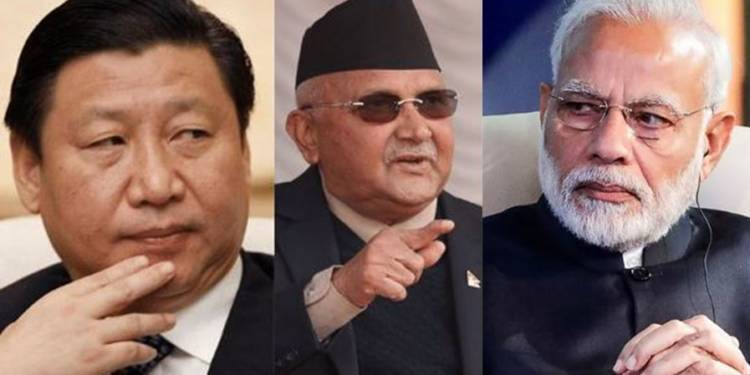Amidst the Wuhan virus Pandemic, the landlocked country of Nepal in the Himalayas is becoming a new battleground for influence between India and China. Over the past one month or so, bilateral ties between India and Nepal have hit an all-time low, following Nepalese Prime Minister KP Sharma Oli’s dangerous brinkmanship against New Delhi.
Beijing is the one calling the shots in Nepal. For the record, it has happened before when Beijing found favour with Mahinda Rajapaksa regime in Sri Lanka before 2015, and in Maldives where China found a puppet regime in Abdulla Yameen’s administration. In both cases, subsequent regime changes neutralised growing Chinese influence, as civilizational ties and goodwill between India and Maldives/ Sri Lanka never got damaged irreparably. Learning from this lesson, China seeks to destroy Indo-Nepal ties irreparably, forever turning Nepal into a client state of China.
China has made deeper, more brutal incursions into Nepalese polity. By using the spinelessness of the Communist regime in Kathmandu, Beijing has been able to ensure that people-to-people ties between India and Nepal get impaired. KP Sharma Oli has ratcheted irredentism by bringing up old, buried territorial disputes and bullets have been fired to claim an Indian civilian’s life. Beijing would consider it quite an achievement to destroy centuries-old ties between New Delhi and Kathmandu.
If one takes a look at the chronology of things, one would realise how Beijing used the opportunity of driving a wedge between Indo-Nepal ties even as India prepared to inaugurate the Dharchula-Lipulekh road, a strategic project that allows India access to the strategically located Lipulekh Pass at a very high altitude of 17,060 feet, and only 4km away from the China border.
There were tensions within the ruling Nepal Communist Party in Kathmandu, and a slit seemed imminent. Enigmatically, the warring factions led by party Chair Pushpa Kamal Dhal and senior party leader Madhav Kumar Nepal came head-to-head just when Beijing would have wanted.
It is also no coincidence that unlikely border disputes cropped up between India and Nepal at the same time when the Indian Army and People’s Liberation Army (PLA) of China troops came face-to-face in Eastern Ladakh.
Even the Indian Army Chief, General MM Naravane said, “There is reason to believe that they (Nepal) might have raised this issue at the behest of someone else and that is very much possibility,” in an indirect reference to China.
Oli risked losing his chair, and this is when the Chinese Ambassador to Nepal Hou Yanqi jumped in, openly and deeply interfering in Nepal’s internal affairs. She held a series of meetings with senior Nepal Communist Party leaders to rescue Oli. Xi Jinping put all his weight behind the Nepalese Prime Minister.
When India’s strategic road project got inaugurated days later, Oli was obliged to return the favour to Xi Jinping. So, Nepal government falsely claimed that the road was built on Nepalese territory.
Oli’s cabinet released a new political map that shows parts of India’s territory- Lipulekh, Kalapani and Limpiyadhura, in Nepal, and Oli himself endorsed it. At the cost of becoming a source of derision himself, Oli has returned the favour of saving his chair to China.
Nepal’s Parliament has now passed the political map that was released by the ruling Nepal Communist Party, and it is not a matter of surprise that other parties, including major Opposition parties including Nepali Congress (NC), Rastriya Janata Party-Nepal (RJP-N) and Rastriya Prajatantra Party (RPP) supported the move to amend the Constitution and include the altered political map.
Border disputes are historically emotive issues associated with nationalism. It is political suicide not to support the amended map, no matter how misleading and erroneous it may be.
Nepalese Prime Minister Oli says, “India has deployed its troops in Kalapani since 1962 and our rulers in the past hesitated to raise the issue.”
He claims that the disputed territory is de jure Nepalese territory, but he doesn’t care to explain why Nepal’s own political maps have not shown these territories in Nepal till date. If this is really Nepalese territory, it is absurd that Nepal’s Parliament had to pass a Constitutional Amendment to insert a new political map.
The artificial enlargement of Nepalese claims however has ensured that Indo-Nepal ties touch a new nadir. Even anti-China, pro-India elements in Nepal are now in a fix. Backed by Xi Jinping, Oli has made the territorial dispute a nationalistic, prestige issue.
No one can therefore afford to oppose this toxic Amendment, and working behind the curtains China has achieved what it so desperately wanted- irreparably damaging Indo-Nepal ties.
To make things worse, an unarmed Bihar farmer has been killed by the Nepal Armed Police on the Indo-Nepal border. This follows several hate-filled speeches by KP Sharma Oli against Indian citizens.
In the Nepal Parliament, he said, “Eighty-five per cent of the people who tested positive for coronavirus in Nepal are those who returned from India. With the start of the movement of people from India, the number of coronavirus cases doubled in just one month in Nepal.”
China has managed a deep incursion into Nepalese politics and is now pulling the strings in Kathmandu. It has managed to create issues- border disputes and killing of an unarmed Indian citizen through the Communist regime in Kathmandu.
Even if there is a regime change tomorrow, acrimony will persist and the two countries might no longer share the bond of open borders with centuries-old ties.
China learnt its lessons from the routs that it faced in the Indian Ocean. New Delhi has a certain advantage in the Indian Ocean Region (IOR) but Beijing wants to ensure that it takes the advantage in the Himalayas.































